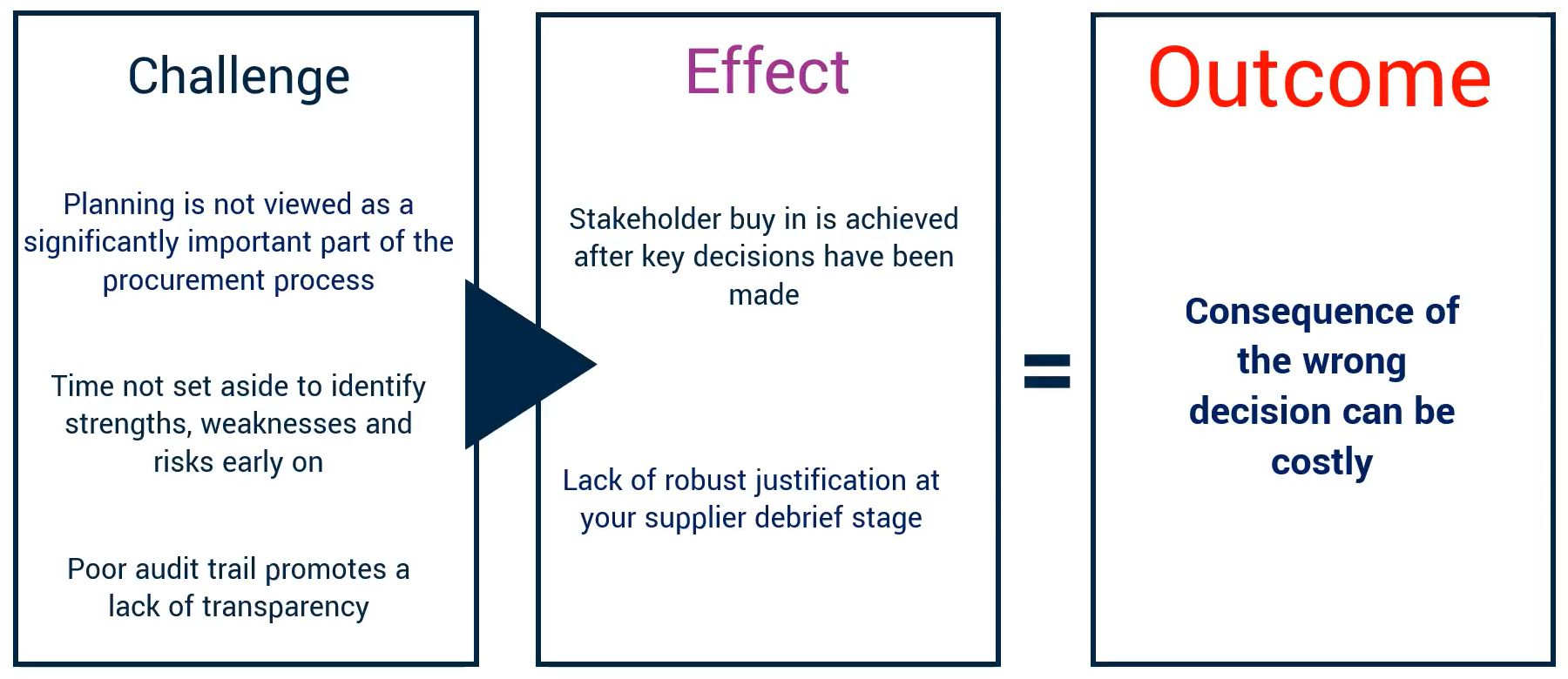Estimated reading time: 7 minutes
Navigating the complexities of procurement projects requires meticulous planning and execution to avoid common pitfalls that can lead to significant legal and financial repercussions. Today, we’ll look at the critical stages of procurement and debriefing, highlighting the challenges that frequently arise and how to mitigate these risks. From maintaining a robust audit trail to ensuring transparent scoring justifications, we’ll explore how upfront planning and thorough documentation can protect your organisation from costly errors.
We’ll also examine the bidder’s perspective, shedding light on why suppliers challenge contract decisions and how procuring authorities can address these issues through clear communication and adherence to procurement laws. By understanding and implementing best practices, organisations can foster fair competition, build stakeholder confidence and achieve successful outcomes.
Continue below to gain actionable insights to strengthen your procurement processes.
Quick links
The Buyer – Procurement Planning and Debrief Pitfalls
We recognise when planning for a large procurement, the challenges can be wide and varied. Whilst there are lots of aspects we could consider at this stage, here are some of the common issues that we’ve come across over the years.

You’ll also see some of the undesirable effects that challenges can have. One of the major pitfalls we’ve encountered is a poor audit trail. This often arises from inadequate mechanisms or processes for capturing and centrally managing information.
How you define the weighting of a question or record your justification for scoring a supplier can lead to poor outcomes and potential legal challenges. When the value of upfront planning is overlooked, and the importance of the initial stages is underplayed, the resulting knock-on effects can lead to costly outcomes for the buying authority.
Unfortunately, these issues are often realised too late, such as when a bidder presents a legal challenge. Failing to allocate sufficient time to address these challenges from the very start can lead to the failure to deliver desired project outcomes. This can be costly both financially and in terms of time lost.
Next, we’ll examine the perspective of a bidder and their reasons for challenging.
The Bidder – Reasons to challenge
Continuing from some of the pitfalls we’ve discussed, let’s now examine why suppliers are increasingly challenging contract award decisions.

We’re seeing a notable rise not only in the number of challenges and inquiries from suppliers but also in the variety of reasons for litigation against procuring authorities.
Legal challenges can be complex, scrutinising a wide range of aspects. While some issues are purely technical, such as errors in calculating numerical scores, others are more sophisticated, questioning the overall decision-making process.
For instance, consider a scenario where a supplier appeals a decision due to inadequate justification received during the debrief. This lack of clarity can lead them to identify and challenge a perceived bias in favour of the incumbent provider.
This highlights the importance of connecting your planning stages with your debrief stages, a point we’ll emphasise throughout. Ensuring that suppliers have access to clear information about their scoring is essential for building confidence that the correct decision was made.
Next, we’ll explore the regulatory environment that permits and enables these legal challenges.
Procurement Law
As we consider procurement law, it’s essential for authorities to comply with legal requirements. Let’s spotlight three key responsibilities: Transparency, Audit Trail and Standstill Period. These areas always require careful consideration when planning and debriefing suppliers. For instance, at the contract award stage, authorities must provide rejected bidders with prescribed information, such as the name of the winning provider and the characteristics of the winning bids. This is where competition planning and decision-making by procuring authorities come under the most scrutiny, necessitating robust justifications that can withstand any opposition.

Transparency and audit trails are intertwined and should be integral to every aspect of procurement. Today, we’ll explore what can go wrong when awarding a contract and the potential reputational damage that could result.
If it goes wrong, it can happen quickly
There’s a noticeable increase in case law making headlines, highlighting not only the financial repercussions of errors but also the severe reputational damage inflicted on the procuring authority and the personnel involved.
Reflecting on what we’ve covered so far, it’s clear that these issues emphasise the critical importance of buyers understanding the connection between procurement law and their planning processes. This understanding significantly impacts the success of debriefing bidders.
So how do you protect yourself against legal challenges and poor outcomes?
Having examined the consequences of making mistakes, it’s important to address a crucial question: how do you protect yourself against legal challenges and poor outcomes? In the following section, we’ll explore some of our methodologies and solutions that help organisations overcome the issues and challenges we’ve discussed today.
Best Practice
To answer this question, lets introduce the core principles of Plan, Prepare and Execute. Each principle encompasses key components that guide you through every stage of your procurement planning activities. By structuring your procurement process this way, you not only establish a clear legal framework with well-defined decision-making schemes, but you also demonstrate to all stakeholders the necessary deliverables to achieve a successful outcome.

This structured approach ensures transparency and robustness throughout your project. Let’s now explore each principle – Plan, Prepare and Execute – in more detail.
Plan
We begin with the planning stage. Here, a procuring authority examines the context of its procurement, addressing the challenges to provide an optimised solution that meets goals on time and within budget. It’s crucial at this point to engage all stakeholders and subject matter experts, ensuring that the procurement objectives align with the needs of the intended beneficiaries.
Prepare
Next, we move to the Prepare stage. This phase involves testing with industry and securing stakeholder agreement on the procurement details and success metrics, which are essential for a successful competition. This stage also includes developing and weighting your evaluation criteria, selecting your preferred pricing methodology, finalising your assessment scheme and completing your tender documentation.
Execute
In the Execute stage, you assess bidders and determine the winning supplier. This phase involves several elements, such as gathering relevant information from written bids, reviewing evaluated scores during moderation, reconciling differences of opinion, and ensuring the evaluation is free from bias. As you score the submissions, you reach the point of selecting the best tenderer, with your justification forming the basis of the supplier debriefing letter.
It’s important to note that although the final decision to award the contract to the preferred bidder happens in the later stages, the selection of the winning provider essentially begins much earlier. This initial selection occurs when you design your evaluation framework, setting the stage for the final decision-making process.
By following this pathway — Plan, Prepare, Execute — you create a clear, structured approach to procurement that promotes transparency, mitigates risks and ensures a successful outcome.
AWARD®
In this section, we’ll provide an overview of AWARD® for both newcomers to our software and services, as well as those looking to stay updated on our latest solutions.
The AWARD® Solution comprises several modules designed to enhance strategic evaluations. It’s particularly useful in the early stages of procurement, before going out to competition. Our Structured Criteria Development module helps you create robust, fit-for-purpose criteria. Additionally, our weighting tool allows you to develop and define the importance of your criteria weighting.
Stakeholders can perform sensitivity analysis using their criteria, weighting and preferred price methodology. This analysis can be conducted with suppliers you’ve engaged with before going to market, ensuring your strategy is sound.
In our next blog, we’ll show you how the debrief functionality works in AWARD®. This feature promotes fair and transparent competition, significantly reducing the risk of legal challenges. Our customers have found this to be a crucial part of the AWARD® Solution. We hope this gives you a glimpse of how AWARD® can benefit your procurement process.
How to produce Bidder Debriefing Reports and Letters
Click thepinkbutton below to continue onto our next blog that will put theory into practice by walking you through how to produce bidder debriefing reports and letters in AWARD®.





